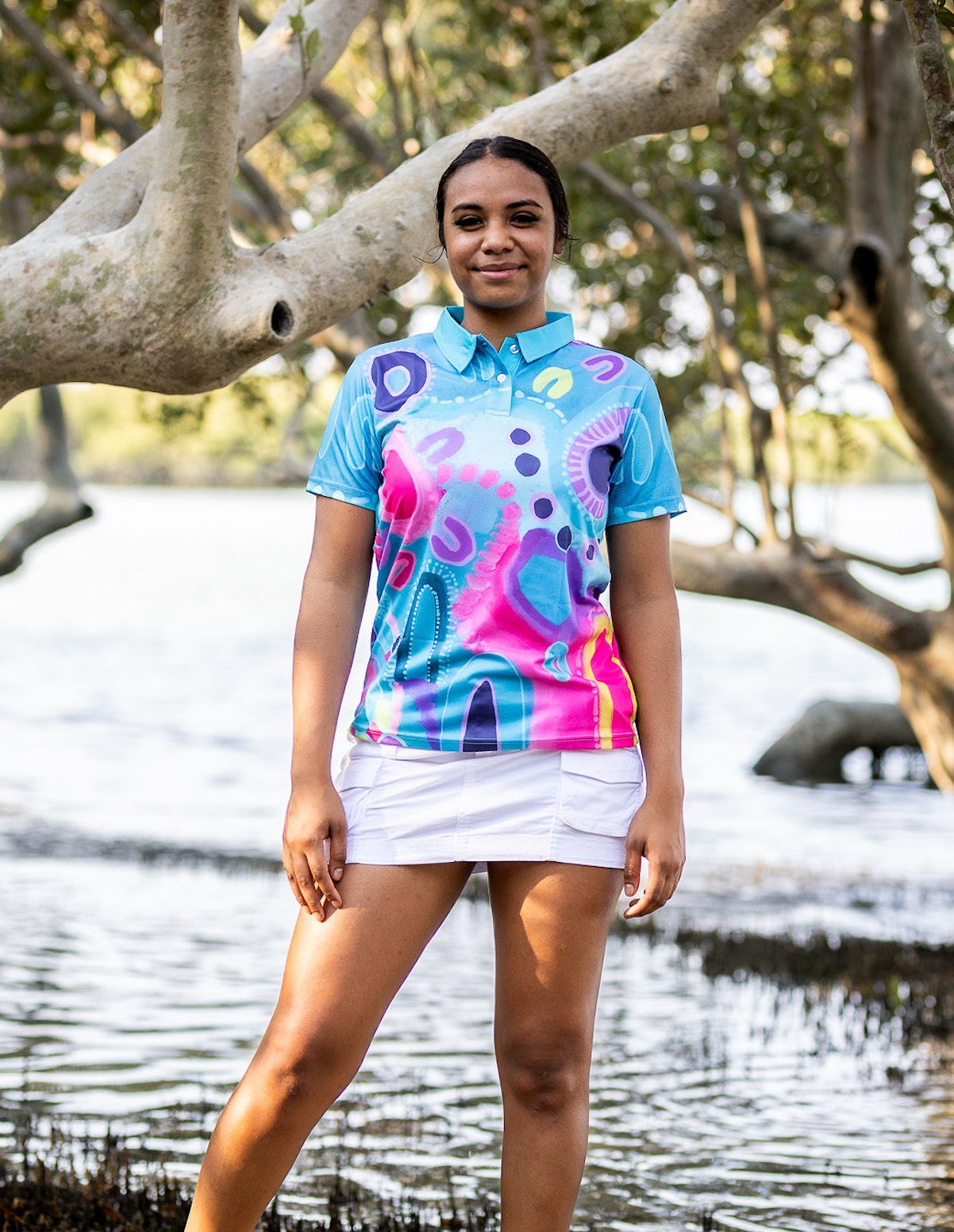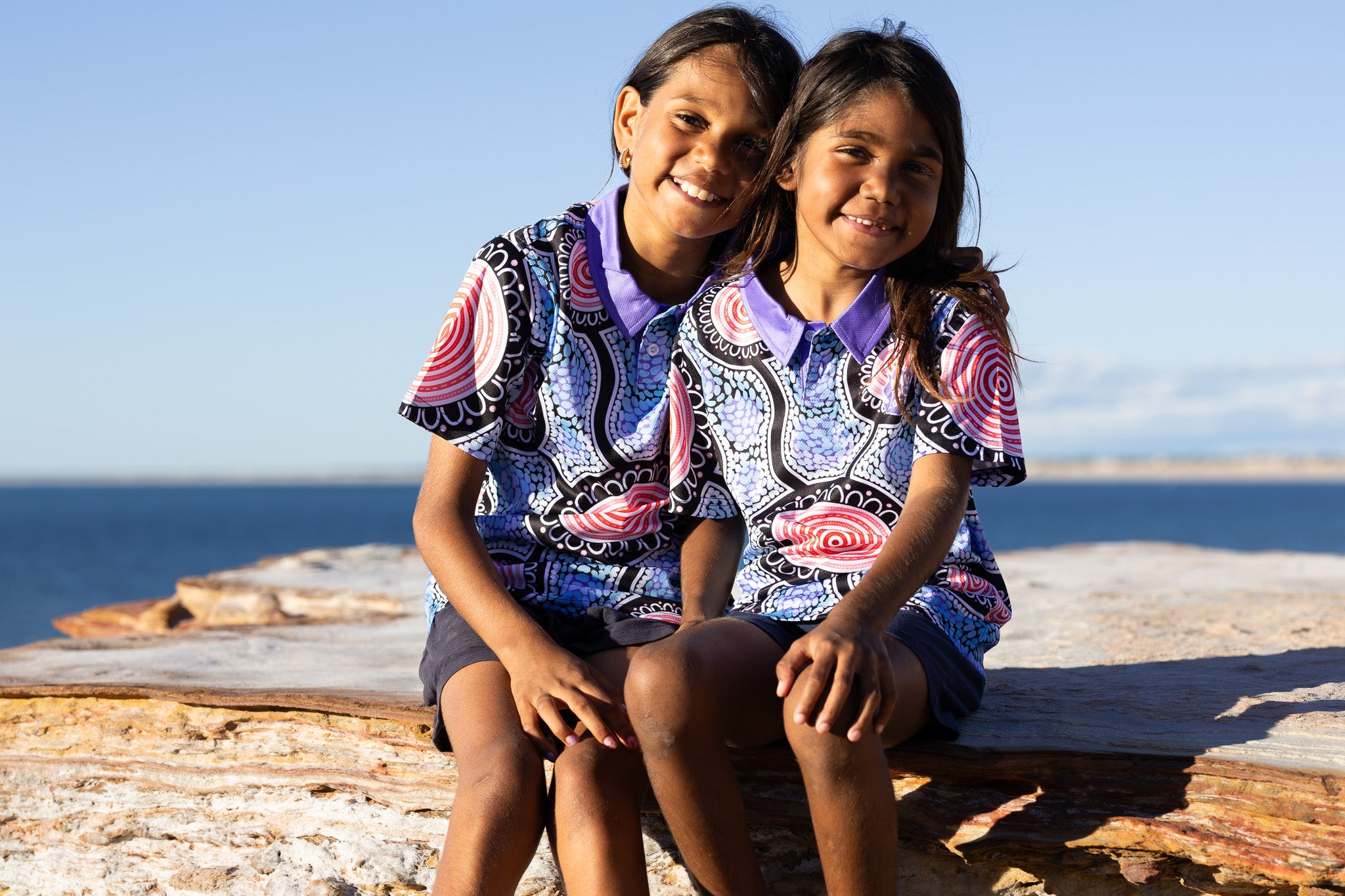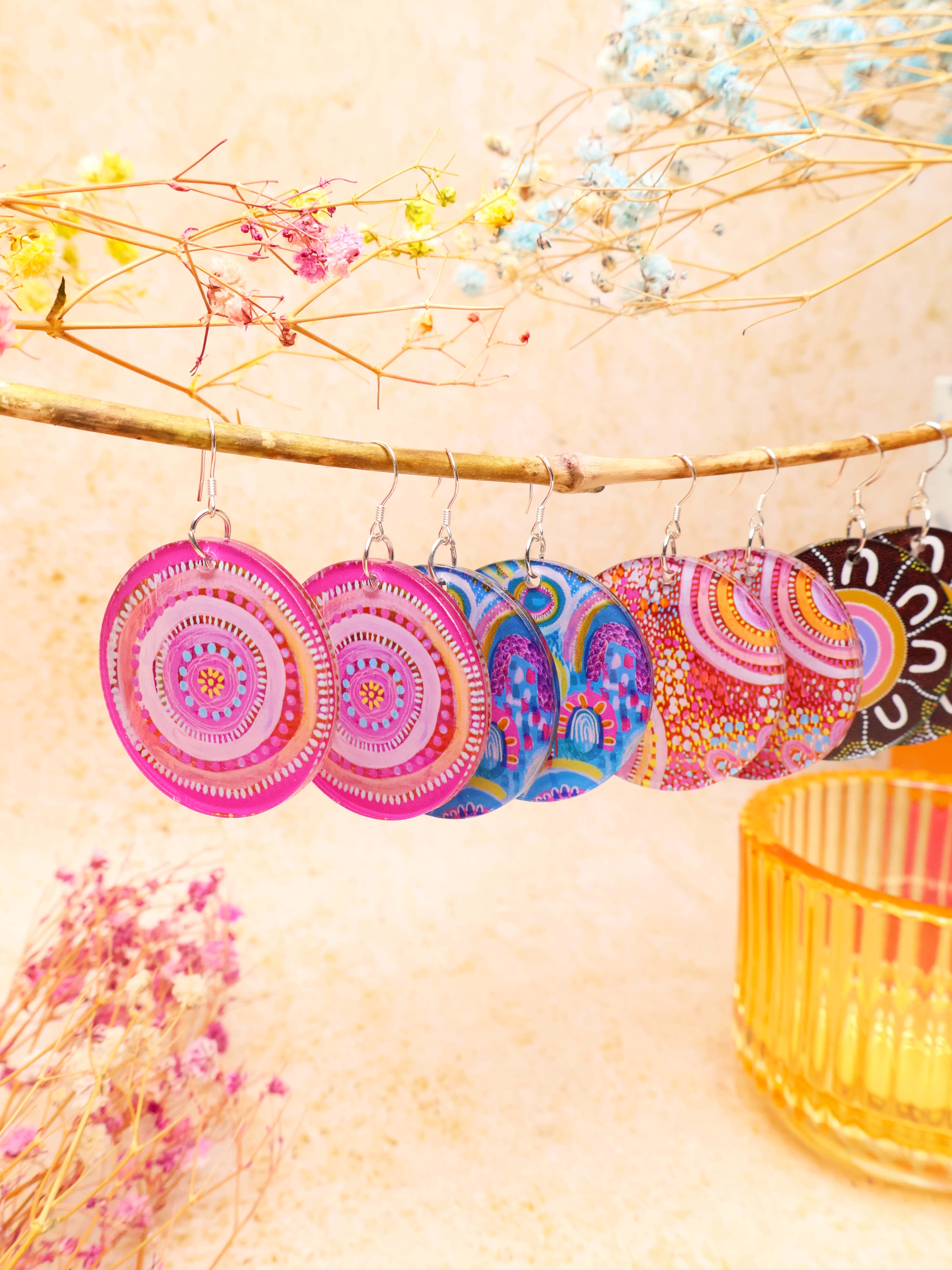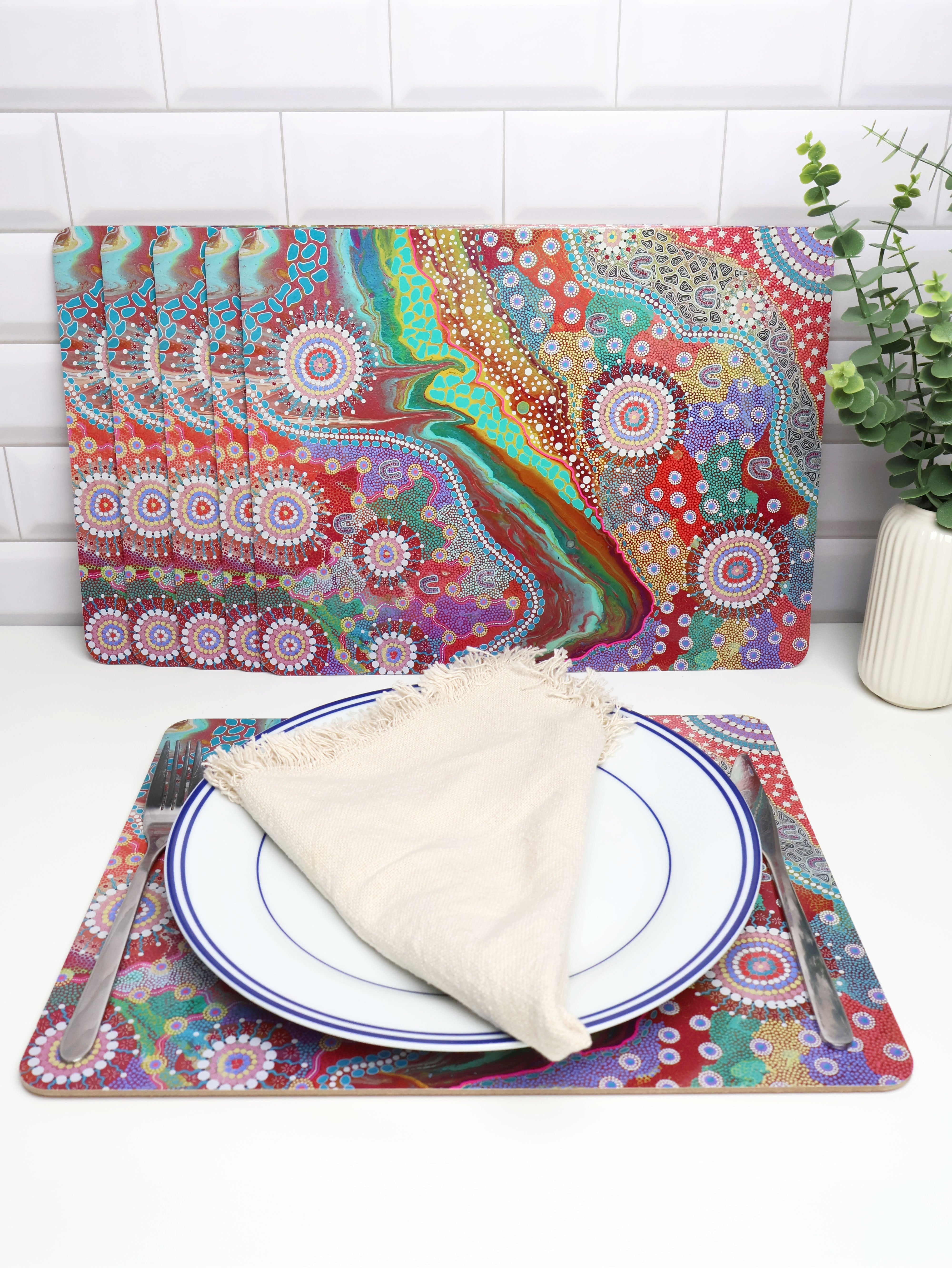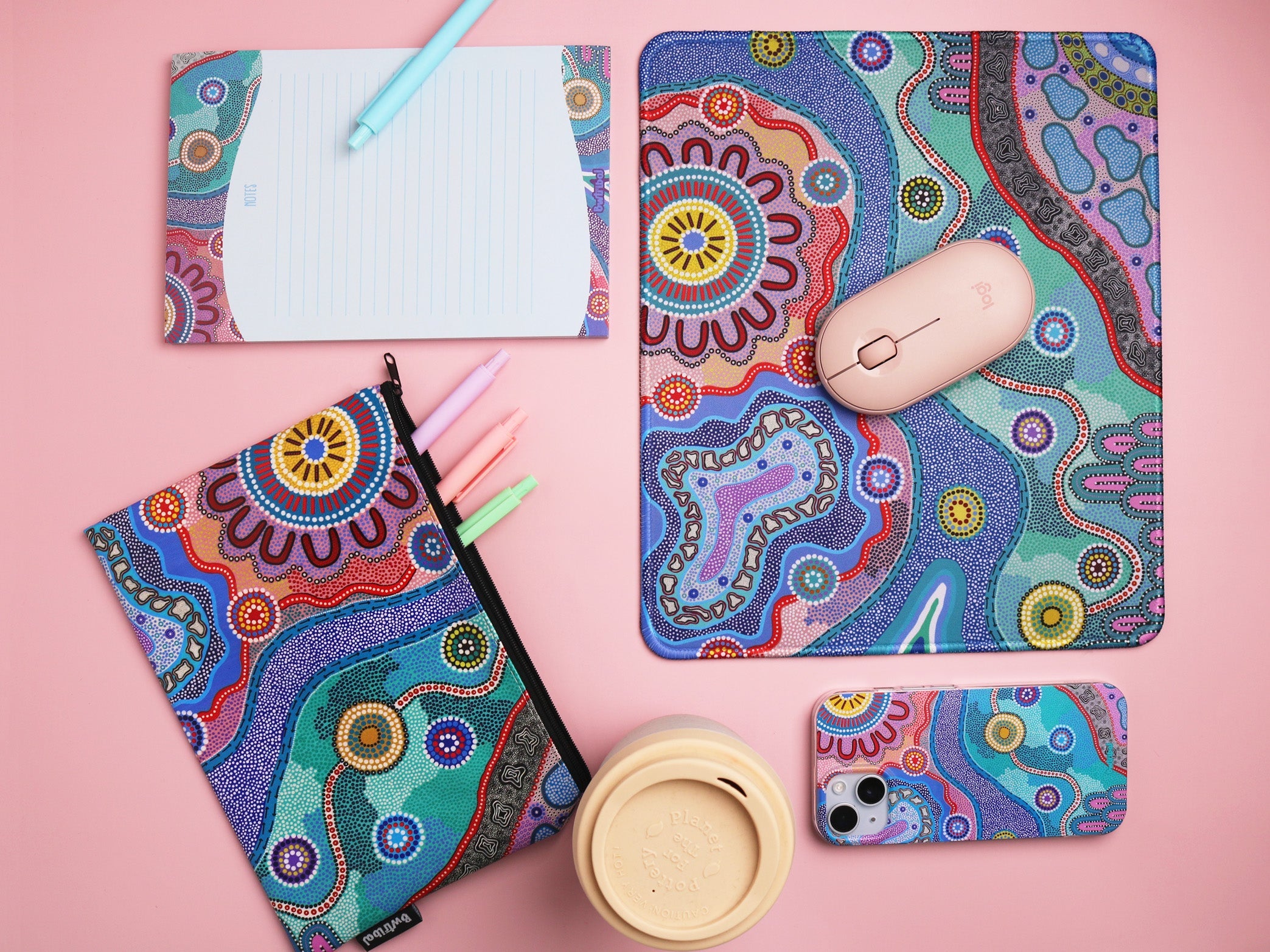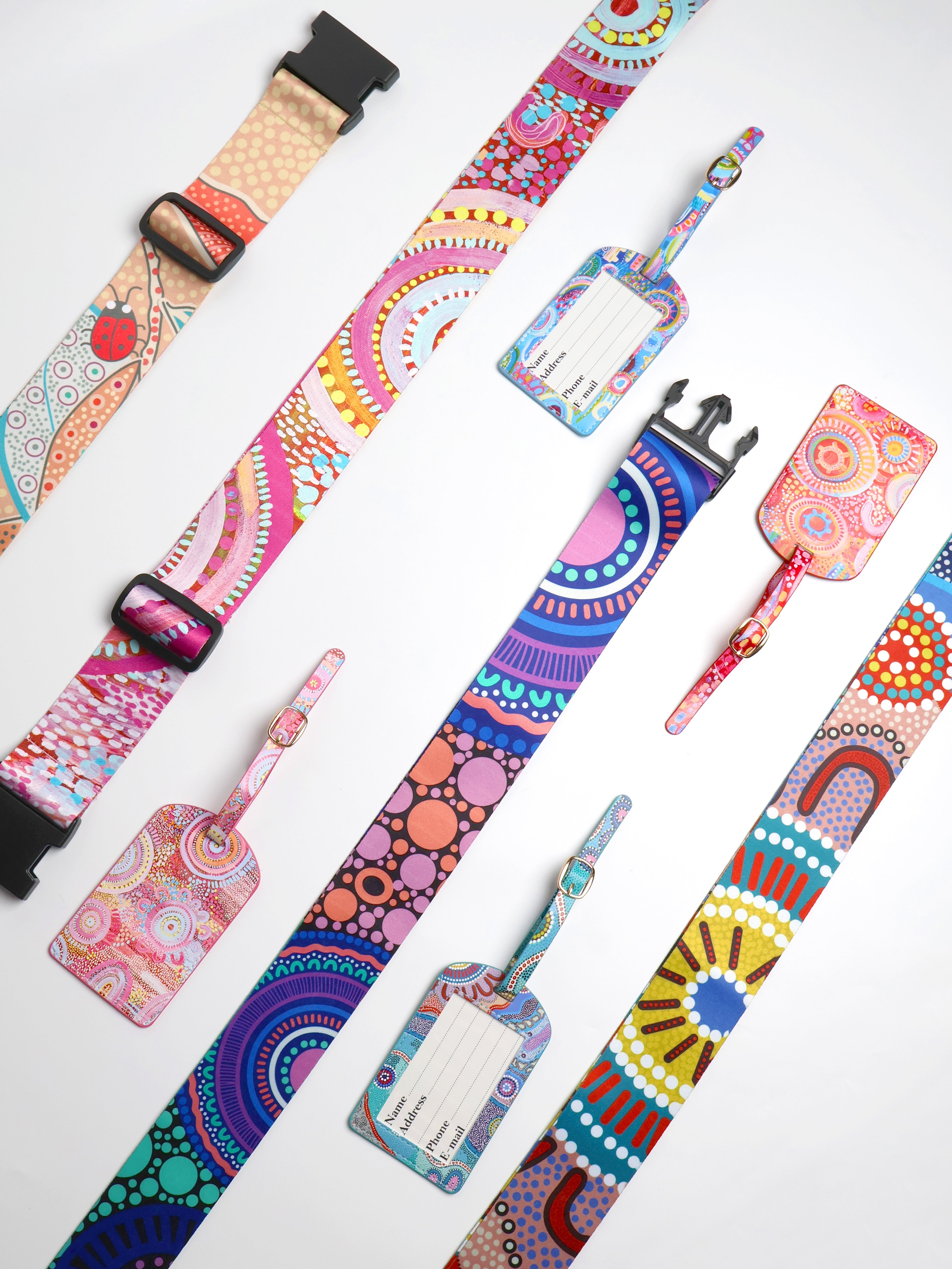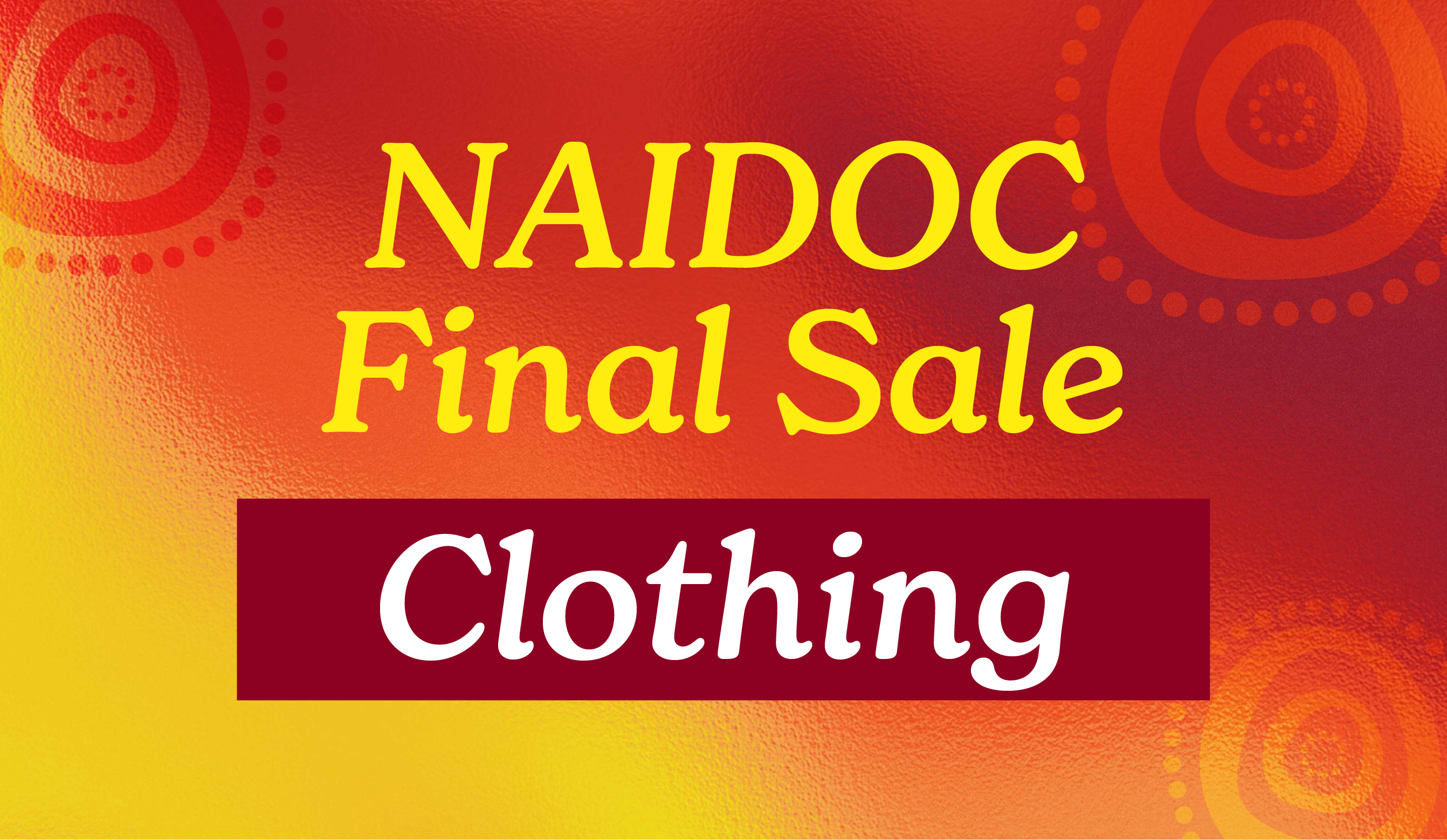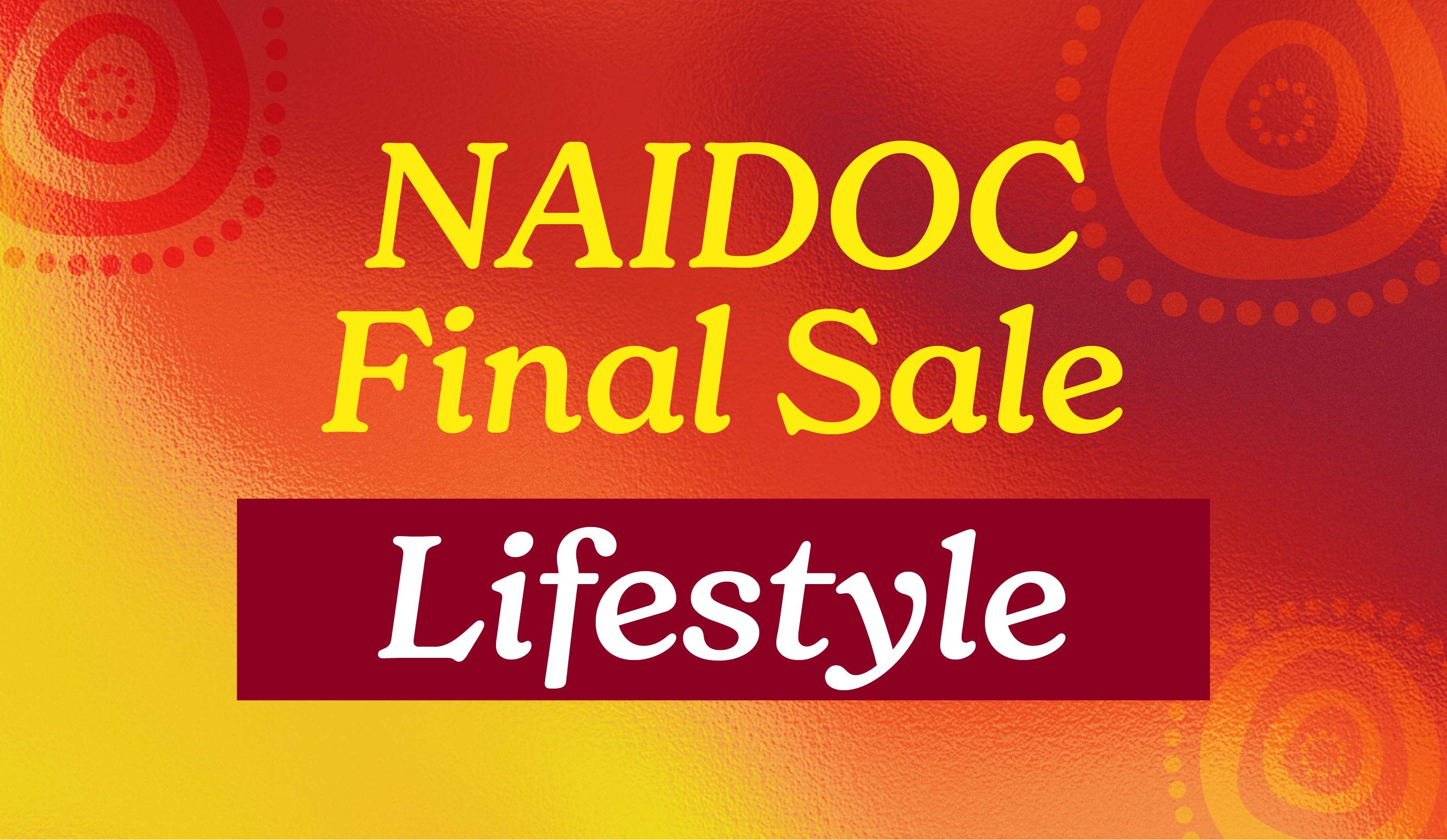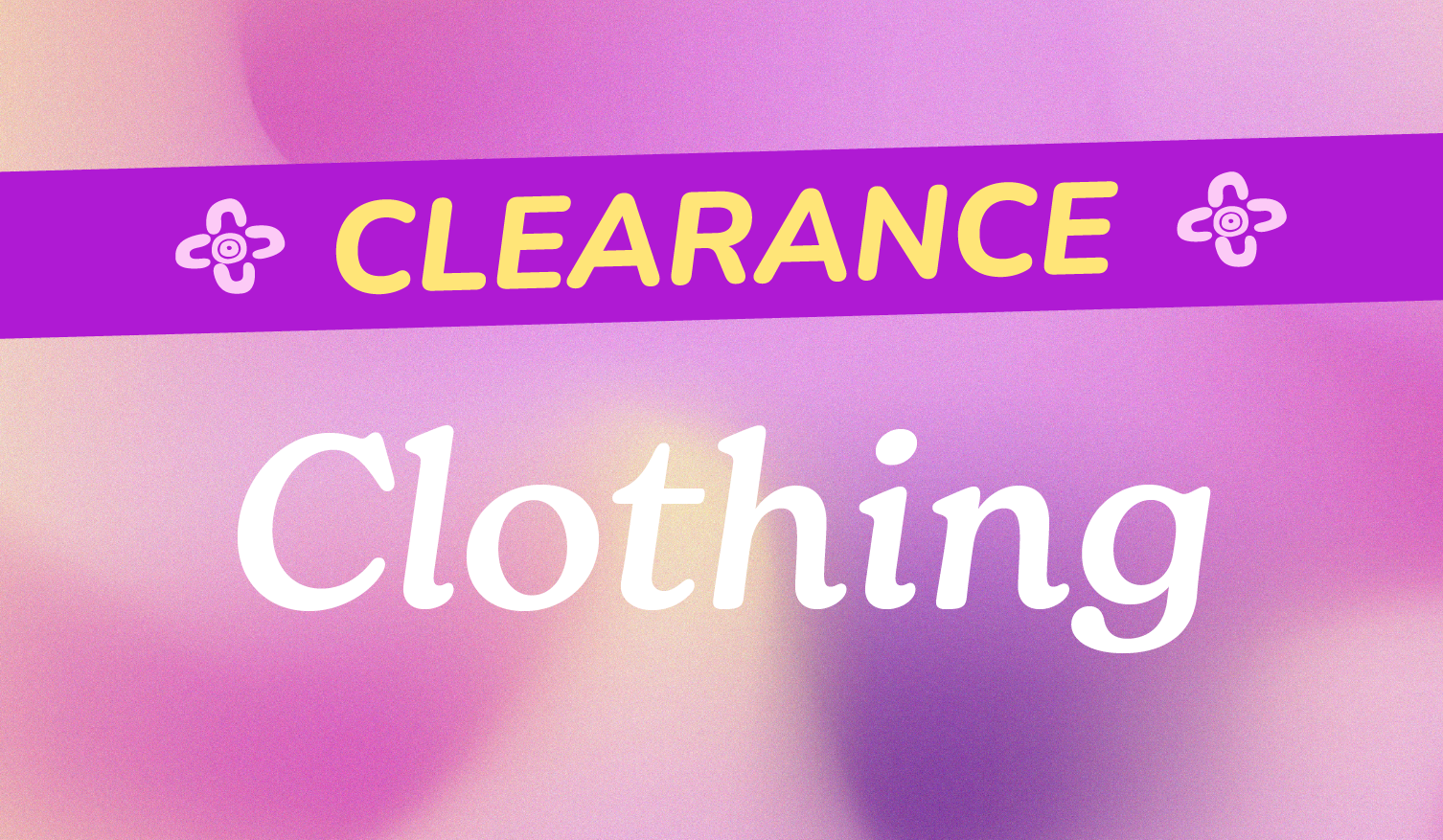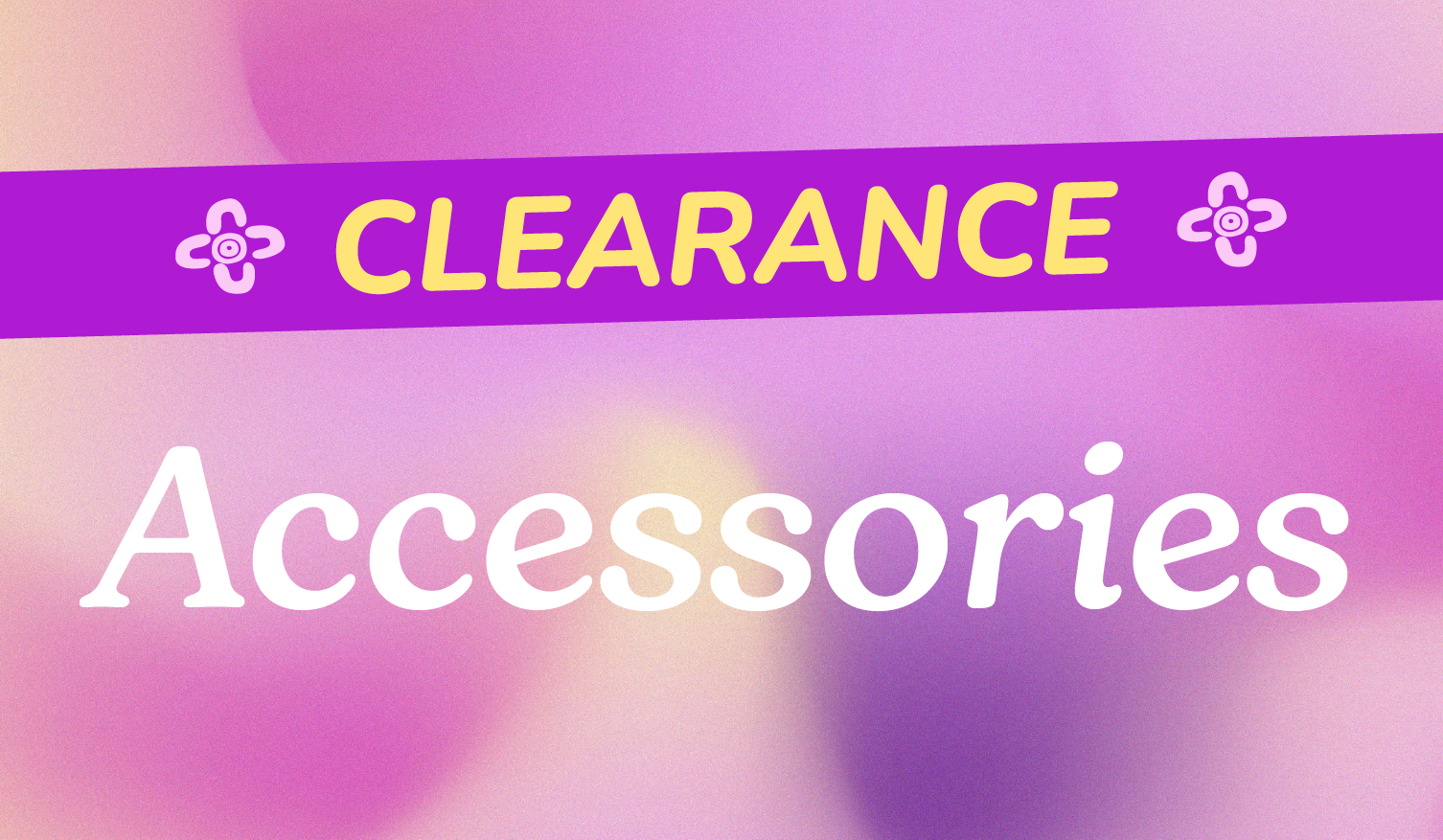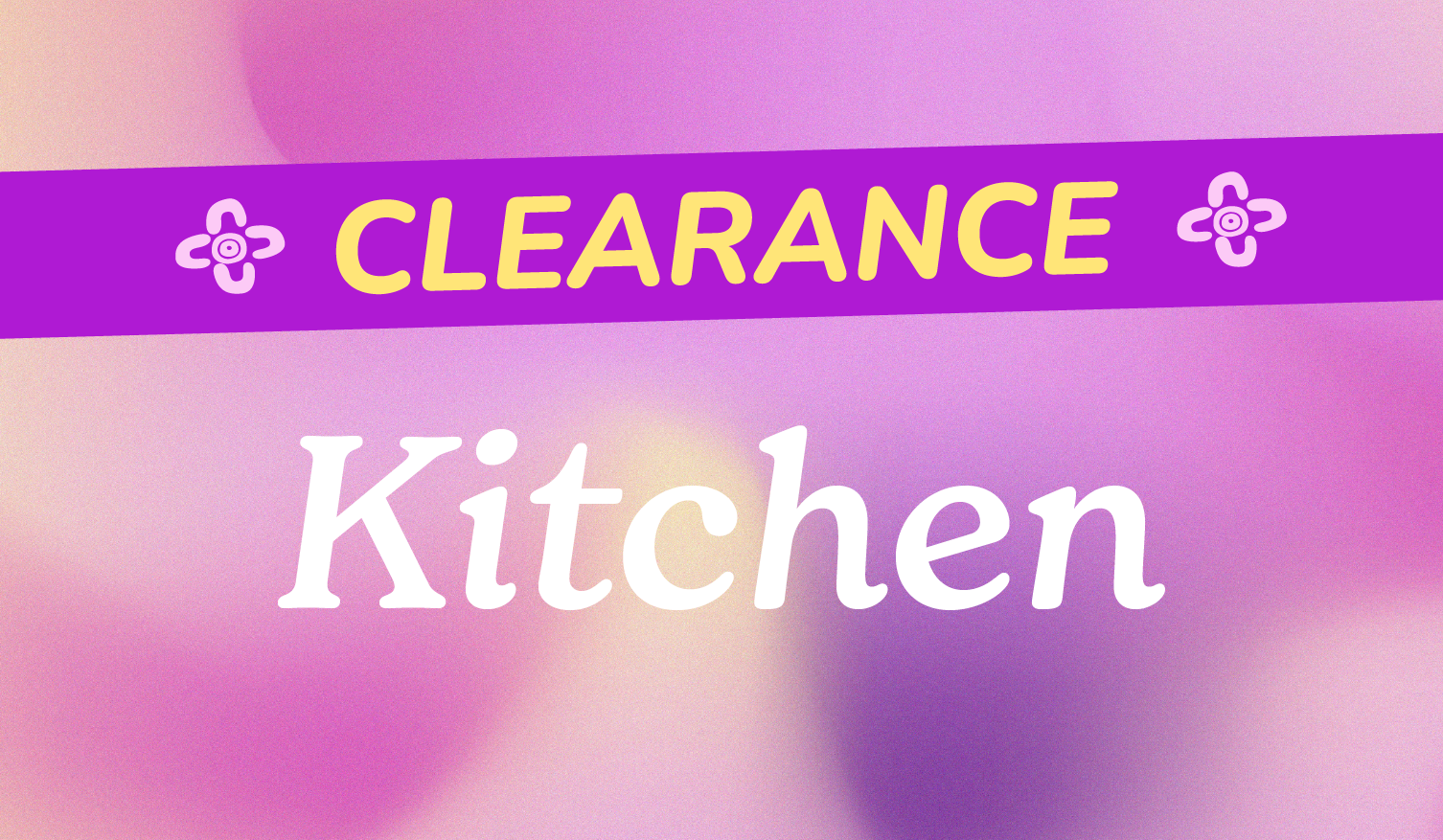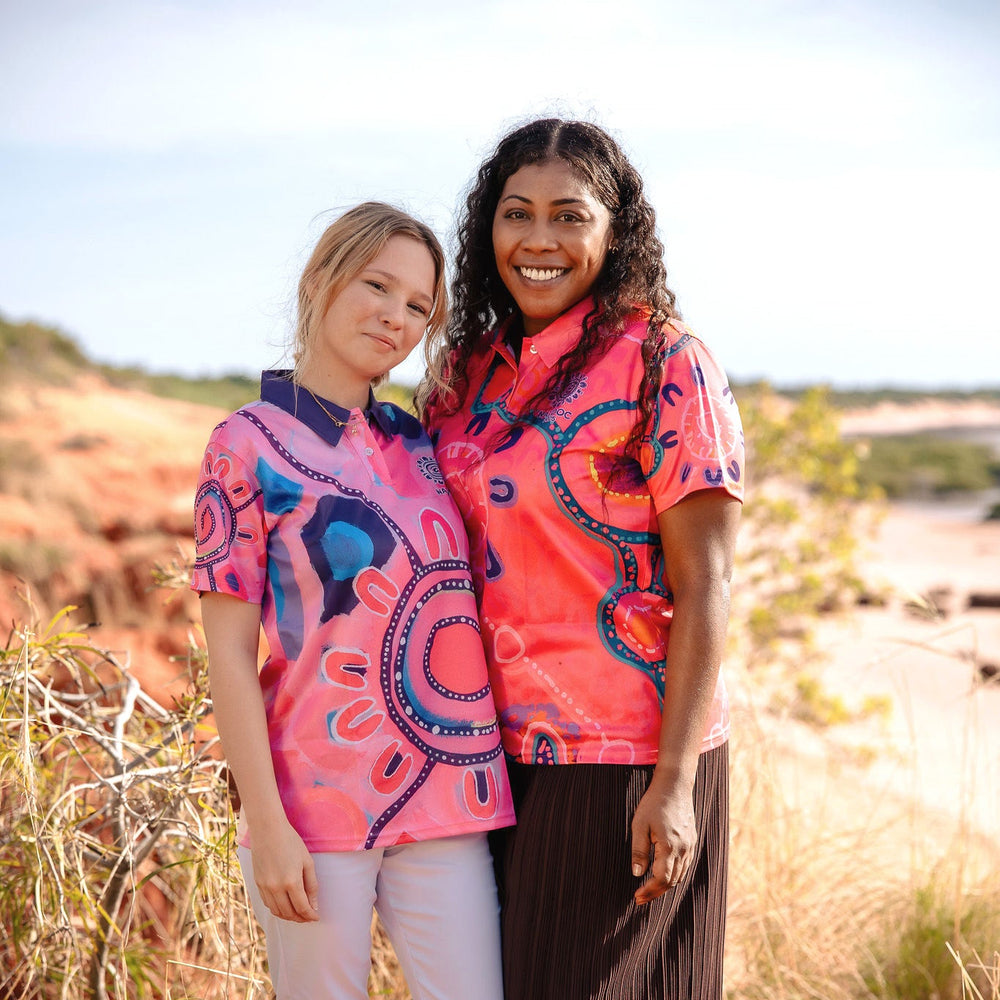ARTIST BIO
All of our collaboration artists receive a percentage of every piece they sell so when you buy from our collaboration pieces, you're not only supporting BW Tribal as a 100% Owned Indigenous Business but you're also supporting local Indigenous Artists!
ALISON SIMPSON // BIO

My name is Alison Simpson (yalidyan – my Wiradjuri name). I am a Wiradjuri woman from central NSW as well as Wemba Wemba from northwest VIC and am culturally connected to many other places. I currently live and work on Djiriganj & Thaua countries within the Yuin nation where I have done so on and off over the past 25 years.
I commenced my artistic journey in 2013 where I started painting for therapeutic reasons and have done so in my spare time ever since. I have a brother and sister who are also Aboriginal artists. My artworks are considered as contemporary, and I generally use acrylic paints on canvas. My artworks are often quite bright using an array of different colours.
The inspiration for the narratives I create through my artworks come from the landscape, environment or surroundings which I am in, the people I am with and the experiences I encounter.
STORY BEHIND THE ART // JAANDA FESTIVAL
Jaanda (pronounced jarn - da) is an Aboriginal word from the ‘south coast language as spoken by Elders’ language dictionary and means humpback whale.
From May to November each year, the humpback whales – or the Jaanda - start their migration South to Antarctica. Between August and November, you will see many of these Jaanda on the far south coast of NSW where they stop along the way to feed their young. During this time, they put on a spectacular show for onlookers who get to witness these majestic animals in the wild breaching and doing tail slaps, just like their having their own Jaanda festival.
JOEL SAM // BIO

Joel Sam is a contemporary Indigenous artist residing in Cairns. He is a direct descendant of the clans of Saibai Island where he spent his early years before moving to Bamaga to complete high school, the place he calls home. His work explores his personal engagement with Torres Strait Island culture and family stories through the processes of printmaking and sculpture.
The use of traditional clan Minarel (pattern) embedded within his images is characteristic of Joel’s work. Totemic designs include Umai (dog), Koedal (crocodile), Baydham (shark), Waru (turtle) and Samu (cassowary) connected through ancient familial bonds. Often interwoven, these designs allow Joel to express a more intricate visual language representative of the complexities of his Saibai Island heritage.
STORY BEHIND THE ART // "COCONUT SHELL WATERBOTTLE"
Coconut Shell Waterbottle - The three fish hooks symbolise strength, good luck and safe travels, wherever we travel we need water to keep us going. This depicts the coconut shell water bottle which represents rebirth of life in different forms.
STORY BEHIND THE ART // "VOICE, TRUTH, & TREATY"
Voice, Truth & Treaty - In this artwork it depicts the two warriors from the two Indigenous Nations of Australia. The Torres Strait Islander warrior blowing a trumpet (Bu) shell which represents that calling of people to a gathering. As the same with the Aboriginal warrior, the clapping of the boomerang guiding & welcoming people to the gathering, with one voice. The patterns in the front and on the sleeves represent people from all different clan groups. As the people walk towards Uluru which signify the heart/center of Australia, the ongoing struggles, the arches with people past, present and future working with the different tier of Governments to achieve the truth the inclusion of indigenous people in decision making, the scroll on the back artwork resembles the treaty.
KARLA MCGRADY // BIO

Karla McGrady is a Gamilaraay woman, born and raised in Tenterfield NSW, her artwork reflects on stories and lessons learned throughout her life. Her work is inspired by her love of art and storytelling, encouraged by her family members that she would often spend hours sitting and watching them paint and draw. Her work often incorporates vibrant colours or earthy tones that help describe each individual story in a way that only she can tell it.
STORY BEHIND THE ART // "MEDICINE LEAVES"
Medicine Leaves - My people use Eurah leaves for cleansing and smoking ceremonies and other medicinal purposes, this piece represents the cleansing effect of using these traditional leaves to heal ourselves.
KIYA WATT // BIO

I am a Menang/Gnudju artist born and raised on Noongar boodjah (land) I am located in south west of Australia and currently reside in Albany WA. I have been painting for about 2 years now. I paint contemporary styles using my cultural knowledge to educate and share stories. I use art as a platform to advocate about issues I am passionate about. My family has suffered from government policies so I want to raise awareness around the issues my mob face today due to inter generational trauma. I also hope to inspire other mob to paint and embrace their culture as it is vital for us to have a cultural identity in our communities. Painting has brought so many positive opportunities into my life and I hope through my art everyone can learn something to watch my journey follow me on Instagram @kwaboriginalartist or Facebook @Kiya Watt- Aborginal artist
STORY BEHIND THE ART // "YAKANS"
Yakans - This is a painting depicting the Yakans (which is the Noongar word for long neck turtles) journey. The circles represent the ngamar (waterholes) and the white lines connecting them show the movements and spirit of the Yakans. As they travel together to lay their eggs around pinjars (lakes)
STORY BEHIND THE ART // "WAGUAL (Rainbow Serpent)"
LEAH BRIDESON // BIO

"I am Leah. I am an Aboriginal woman born in Canberra, ACT. My mob are Kamilaroi from my Grandmothers country in the Gunnedah region. I am a self-taught Contemporary Aboriginal Artist and began painting at a very young age. I have been painting in a professional capacity for over 7 years.
"Art is such an important platform to share my culture with the wider community. My art is like a 'visual yarn', people really connect with the stories and meaning behind the work".
A great deal of my artistic vision and inspiration comes from the changing landscapes in my home town, on country and from my journeys to ocean country and beyond. I use layers of fine dotting, line work, colour gradients, Aboriginal symbolism and my signature style of 'cracked earth' landscape throughout my paintings. Kamilaroi country is often dry and cracked, but rich and deep in history, culture and story as represented by the space in between the cracked earth. I pay great attention to detail, natural patterns, light, shade and texture in the landscape.
My paintings often work between two perspectives; landscape and birds-eye view. Through a birds-eye view, I generally map the journeys in which I take, along with my ancestral and cultural ties. As I learn more about my culture and discover my ancestors’ footprints in the landscape, I feel the urge to paint my story, my sense of place."
STORY BEHIND THE ART // "OCEANS EDGE"
Oceans Edge - Oceans Edge represents the flow and relationship between land and ocean from an aerial perspective. There is a lot happening in our lives, we sometimes forget to slow down and we lose the flow. Relating the constant tide coming in and out and the untiring flush of waves to the ups and downs in our lives puts things in perspective. Looking out to the ocean reminds me to take a breath, take a step back, ground my feet in the Earth, focus on family and what is important right now, and find a better flow to the busyness of life. The first rush of salt water over my feet as I step in to the ocean is a feeling of freedom.
STORY BEHIND THE ART // "WATER ILLUMINATED"
Water Illuminated - Water Illuminated is a representation of the flow of water on country. The sun rays enlighten the ripples of the water and the underlying texture of country as the water flows through. I appreciate looking at the little details and finding different ways to paint movement and flow with colour intertwined, particularly water and its ever changing colours as it reflects and dances with light.
STORY BEHIND THE ART // "YALIWUNGA NGUWA (Always Here)"
This artwork represents the NADIOC theme, "Always Was, Always Will Be" through our ongoing connection to this country, our Mother Earth. We have been here for 65,000+ years. We have survived through environmental change, through colonisation and the continual impacts of both because we hold the knowledge of how to care for country, with her in turn caring for us. Country is central to our being, our reason and our life source. We have a fundamental role in ensuring her voice is heard, her needs are met and to ensure she stays healthy for our children's futures by treading lightly and fighting for her. The pathways symbolise sharing her voice across the land, whilst the meeting place depicts coming together, listening, learning, taking action and acknowledging the knowledge, cultures, and longstanding custodianship and connection to the country of First Nations People.
PETA-JOY WILLIAMS // BIO

Peta-Joy Williams is a Wiradjuri woman, born in Sydney. With her feet firmly in both cultures, the inland and the salt water. Peta Joy finds an affinity with both and finds inspiration from unique elements of the two diverse nations. PJ has been involved with the Arts since her young school years. Painting Aboriginal art from Pre-School years with many pieces throughout her educational career being submitted into competitions. PJ then went on, after High School to complete a Cert IV in Aboriginal Art and Cultural practices and a Diploma in Fine Arts. PJ currently teaches Wiradjuri at Eora College, facilitating art workshops and mural projects. PJ is the sole operator of Wiradjuri Wave, custom Aboriginal artworks on sports paraphernalia and fashion.
STORY BEHIND THE ART // "GROUNDED IN WATER"
Grounded in Water - Grounded in Water is about feeling a connection to country by cleansing yourself by putting your feet in natural flowing water. When recharging yourself in water you help connect yourself to mother earth and can feel her breath wash over you. Take your shoes off and take in the energy of the earth and ground yourself. The water heals all.
RION SAVAGE // BIO

Torres Strait Islander Artist, Clans: Kulkalgal, Kaurang, Seven Rivers. Born in Mt. Isa grew up in Cairns, travelled to Torres Strait communities, Rennel island, Yorke Island, Darnley Islands, lived with grandfathers, uncles, cousins, seeing the time and patience required in preparing for community gatherings, feastings. Participated in cleaning of land, planting coconut trees, fishing, hunting, and collecting shell fish, experiencing culture first hand has inspired the images and art I produced to honour our ancestors' way of life, and to encourage the survival of our cultural practices into future generations.
STORY BEHIND THE ART // "GELAM"
Gelam - Gelam was a boy who lived in the Torres Strait known as Moa Island. He would go out everyday hunting for small birds with his bow & arrow. He would bring the birds home and keep the fat birds for himself & give his Mother the lean birds. His Mother noticed this and decided to teach him a lesson. The next day she dressed up as a dogai by covering herself in the mud. She scared Gelam so much he dropped his bow and arrow and ran home. That night he noticed his Mother had mud behind her ears & he realised she had played a trick on him. He was so upset that the next day he carved a canoe in the shape of a dugong, gathered up fruits & seeds & soil & set off with the tide. His Mother saw him in the canoe & began to cry. Gelan drifted with the tide crying along the way, until he reached the top of the The Great Barrier Reef. As far away from his Mother as he could. Still today when you travel to the Torres Strait flying over Centrals Islands, some of them look like the tears of Gelam. And Murray Island looks like the shape of a dugong in the horizon.





